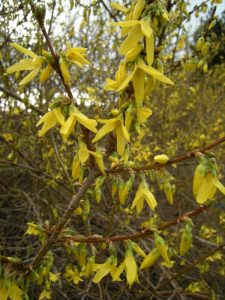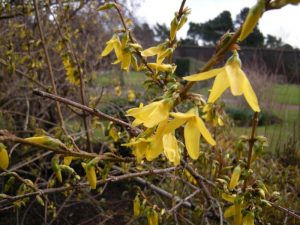This is a plant everyone is aware of – in the gardens of suburbia, filling borders in country gardens, competing well in mixed hedgerows, this bright yellow unruly shrub spills into colour in every municipal park throughout Britain.
What makes Forsythia so popular? It is tolerant of all soils and conditions, but prefers full sun to shade and loves neglect; in fact when left alone to become a conglomerate of twigs, the plant becomes an ideal nesting site for the bird population. It roots easily as softwood, semi ripe and hardwood cuttings.
The genus was named after William Forsyth, a Scot, credited with constructing the first rock garden in England and a founder member of the RHS.
The F. x intermedia hybrid has many named cultivars ‘Lynwood’ and ‘Spectabilis’ being the most popular. These are selected crosses between F. suspensa and F.viridissima. Established specimens of both these cultivars are growing near the North Gate.
There is a collection of species and other cultivars growing in the south-west corner of the Garden, where the minute differences in colour and flower form can be observed, compared and contrasted. Observe, for example, an original Reginald Farrer collection from 1930, F. giraldiana, with prominent pin-like stigma and style. In contrast the cultivars have prominent anthers. In all of them, last season’s growth is covered in pointed flower buds encased by fresh green sepals.


